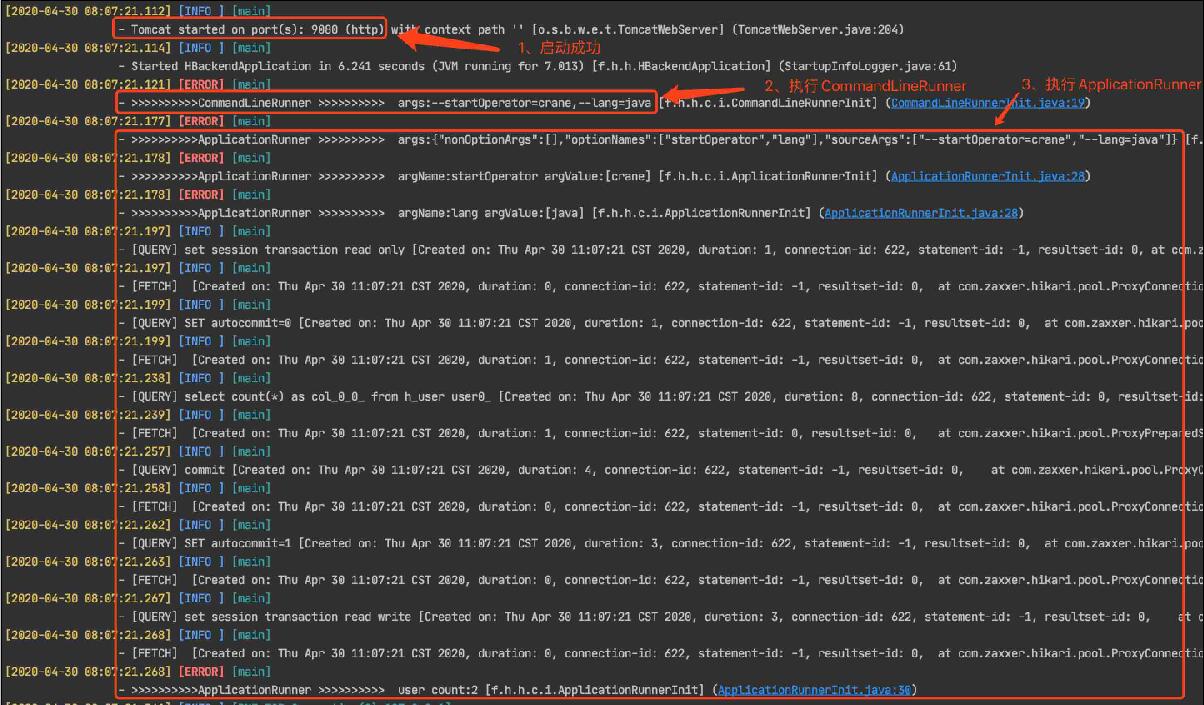这篇文章主要讲解了“CommandLineRunner和Application怎么使用”,文中的讲解内容简单清晰,易于学习与理解,下面请大家跟着小编的思路慢慢深入,一起来研究和学习“CommandLineRunner和Application怎么使用”吧!
在SpringBoot项目中创建组件类实现CommandLineRunner或ApplicationRunner接口可实现在应用启动之后及时进行一些初始化操作,如缓存预热、索引重建等等类似一些数据初始化操作。
两个接口功能相同,都有个run方法需要重写,只是实现方法的参数不同。
CommandLineRunner接收原始的命令行启动参数,ApplicationRunner则将启动参数对象化。
两个接口都是在SpringBoot应用初始化好上下文之后运行,所以在运行过程中,可以使用上下文中的所有信息,例如一些Bean等等。在框架SpringApplication类源码的run方法中,可查看Runner的调用时机callRunners,如下:
/**
* Run the Spring application, creating and refreshing a new
* {@link ApplicationContext}.
* @param args the application arguments (usually passed from a Java main method)
* @return a running {@link ApplicationContext}
*/
public ConfigurableApplicationContext run(String... args) {
StopWatch stopWatch = new StopWatch();
stopWatch.start();
ConfigurableApplicationContext context = null;
Collection<SpringBootExceptionReporter> exceptionReporters = new ArrayList<>();
configureHeadlessProperty();
SpringApplicationRunListeners listeners = getRunListeners(args);
listeners.starting();
try {
ApplicationArguments applicationArguments = new DefaultApplicationArguments(args);
ConfigurableEnvironment environment = prepareEnvironment(listeners, applicationArguments);
configureIgnoreBeanInfo(environment);
Banner printedBanner = printBanner(environment);
context = createApplicationContext();
exceptionReporters = getSpringFactoriesInstances(SpringBootExceptionReporter.class,
new Class[] { ConfigurableApplicationContext.class }, context);
prepareContext(context, environment, listeners, applicationArguments, printedBanner);
refreshContext(context);
afterRefresh(context, applicationArguments);
stopWatch.stop();
if (this.logStartupInfo) {
new StartupInfoLogger(this.mainApplicationClass).logStarted(getApplicationLog(), stopWatch);
}
listeners.started(context);
//调用Runner,执行初始化操作
callRunners(context, applicationArguments);
}
catch (Throwable ex) {
handleRunFailure(context, ex, exceptionReporters, listeners);
throw new IllegalStateException(ex);
}
try {
listeners.running(context);
}
catch (Throwable ex) {
handleRunFailure(context, ex, exceptionReporters, null);
throw new IllegalStateException(ex);
}
return context;
}2.1 CommandLineRunner
简单实现如下,打印启动参数信息:
@Order(1)
@Component
public class CommandLineRunnerInit implements CommandLineRunner {
private Logger logger = LoggerFactory.getLogger(this.getClass());
private final String LOG_PREFIX = ">>>>>>>>>>CommandLineRunner >>>>>>>>>> ";
@Override
public void run(String... args) throws Exception {
try {
this.logger.error("{} args:{}", LOG_PREFIX, StringUtils.join(args, ","));
} catch (Exception e) {
logger.error("CommandLineRunnerInit run failed", e);
}
}
}2.2 ApplicationRunner
简单实现如下,打印启动参数信息,并调用Bean的方法(查询用户数量):
@Order(2)
@Component
public class ApplicationRunnerInit implements ApplicationRunner {
private Logger logger = LoggerFactory.getLogger(this.getClass());
private final String LOG_PREFIX = ">>>>>>>>>>ApplicationRunner >>>>>>>>>> ";
private final UserRepository userRepository;
public ApplicationRunnerInit(UserRepository userRepository) {
this.userRepository = userRepository;
}
@Override
public void run(ApplicationArguments args) throws Exception {
try {
this.logger.error("{} args:{}", LOG_PREFIX, JSONObject.toJSONString(args));
for (String optionName : args.getOptionNames()) {
this.logger.error("{} argName:{} argValue:{}", LOG_PREFIX, optionName, args.getOptionValues(optionName));
}
this.logger.error("{} user count:{}", LOG_PREFIX, this.userRepository.count());
} catch (Exception e) {
logger.error("CommandLineRunnerInit run failed", e);
}
}
}如果实现了多个Runner,默认会按照添加顺序先执行ApplicationRunner的实现再执行CommandLineRunner的实现,如果多个Runner之间的初始化逻辑有先后顺序,可在实现类添加@Order注解设置执行顺序,可在源码SpringApplication类的callRunners方法中查看,如下:
private void callRunners(ApplicationContext context, ApplicationArguments args) {
List<Object> runners = new ArrayList<>();
//先添加的ApplicationRunner实现
runners.addAll(context.getBeansOfType(ApplicationRunner.class).values());
//再添加的CommandLineRunner实现
runners.addAll(context.getBeansOfType(CommandLineRunner.class).values());
//如果设置了顺序,则按设定顺序重新排序
AnnotationAwareOrderComparator.sort(runners);
for (Object runner : new LinkedHashSet<>(runners)) {
if (runner instanceof ApplicationRunner) {
callRunner((ApplicationRunner) runner, args);
}
if (runner instanceof CommandLineRunner) {
callRunner((CommandLineRunner) runner, args);
}
}
}为了便于对比效果,在Idea中设置启动参数如下图(生产环境中会自动读取命令行启动参数):

在上面的两个Runner中,设定了CommandLineRunnerInit是第一个,ApplicationRunnerInit是第二个。启动应用,运行效果如下图:

业务场景:
应用服务启动时,加载一些数据和执行一些应用的初始化动作。如:删除临时文件,清除缓存信息,读取配置文件信息,数据库连接等。
1、SpringBoot提供了CommandLineRunner和ApplicationRunner接口。当接口有多个实现类时,提供了@order注解实现自定义执行顺序,也可以实现Ordered接口来自定义顺序。
注意:数字越小,优先级越高,也就是@Order(1)注解的类会在@Order(2)注解的类之前执行。
两者的区别在于:
ApplicationRunner中run方法的参数为ApplicationArguments,而CommandLineRunner接口中run方法的参数为String数组。想要更详细地获取命令行参数,那就使用ApplicationRunner接口
@Component
@Order(value = 10)
public class AgentApplicationRun2 implements ApplicationRunner {
@Override
public void run(ApplicationArguments applicationArguments) throws Exception {
}
}@Component
@Order(value = 11)
public class AgentApplicationRun implements CommandLineRunner {
@Override
public void run(String... strings) throws Exception {
}
}感谢各位的阅读,以上就是“CommandLineRunner和Application怎么使用”的内容了,经过本文的学习后,相信大家对CommandLineRunner和Application怎么使用这一问题有了更深刻的体会,具体使用情况还需要大家实践验证。这里是亿速云,小编将为大家推送更多相关知识点的文章,欢迎关注!
免责声明:本站发布的内容(图片、视频和文字)以原创、转载和分享为主,文章观点不代表本网站立场,如果涉及侵权请联系站长邮箱:is@yisu.com进行举报,并提供相关证据,一经查实,将立刻删除涉嫌侵权内容。